Sanford-Burnham
Sanford-Burnham
Sanford-Burnham
You also want an ePaper? Increase the reach of your titles
YUMPU automatically turns print PDFs into web optimized ePapers that Google loves.
HTRF Symposium<br />
Avignon, France<br />
April 26, 2013<br />
<strong>Sanford</strong>-<strong>Burnham</strong><br />
Medical Research Institute<br />
(La Jolla, CA)
HTRF ® -powered detection of<br />
ubiquitin-like protein signaling<br />
and interactions<br />
Eduard Sergienko, Ph.D.<br />
Director, Assay Development
• SBMRI and CPCCG<br />
• NIH Roadmap Initiative Screening<br />
Network<br />
• UBL signaling cascades and related<br />
projects within CPCCG<br />
• Acknowledgements<br />
Topics
Development of <strong>Sanford</strong>-<strong>Burnham</strong><br />
Medical Research Institute<br />
National Cancer<br />
Institute designation<br />
conferred<br />
Renamed:<br />
The <strong>Burnham</strong><br />
Institute<br />
Infectious &<br />
Inflammatory Disease<br />
Center is established<br />
Diabetes & Obesity<br />
Research Center<br />
established<br />
1976 1981 1989 1996 1999 2002 2004 2006 2007 2010<br />
La Jolla Cancer<br />
Research Foundation<br />
established<br />
Del E. Webb Center for<br />
Neurosciences and Aging<br />
established<br />
<strong>Sanford</strong> Center for<br />
Children’s Health<br />
Research established<br />
Renamed:<br />
<strong>Sanford</strong>-<strong>Burnham</strong><br />
M. R. Institute<br />
4
Development of <strong>Sanford</strong>-<strong>Burnham</strong><br />
Medical Research Institute<br />
National Cancer<br />
Institute designation<br />
conferred<br />
Renamed:<br />
The <strong>Burnham</strong><br />
Institute<br />
Infectious &<br />
Inflammatory Disease<br />
Center is established<br />
Diabetes & Obesity<br />
Research Center<br />
established<br />
1976 1981 1989 1996 1999 2002 2004 2006 2007 2010<br />
La Jolla Cancer<br />
Research Foundation<br />
established<br />
Del E. Webb Center for<br />
Neurosciences and Aging<br />
established<br />
<strong>Sanford</strong> Center for<br />
Children’s Health<br />
Research established<br />
Renamed:<br />
<strong>Sanford</strong>-<strong>Burnham</strong><br />
M. R. Institute<br />
La Jolla<br />
Est. 1976<br />
•2 Sites of operation<br />
•1200 People (over 500 Ph.D. scientists)<br />
•89+ Faculty<br />
•$175 MM annual operating budget<br />
Orlando<br />
Est. 2007<br />
5
<strong>Sanford</strong>-<strong>Burnham</strong> Medical Research Institute<br />
(Florida site)<br />
• Occupied: April 2009<br />
• 175,000 sq ft facility<br />
• Part of Lake Nona Medical City<br />
• 14,000 sq ft AAALAC-certified vivarium (rats & mice)<br />
• Largest GOLD LEED independent scientific facility in Florida<br />
• ~30 Principal Investigators; ~300 employees (Phase I capacity)<br />
6
<strong>Sanford</strong>-<strong>Burnham</strong>’s Discovery Research Programs<br />
Tumor Microenvironment<br />
Tumor Development<br />
Signal Transduction<br />
Apoptosis & Cell Death Research<br />
Degenerative Disease Research<br />
Stem Cells & Regenerative Biology<br />
Development & Aging<br />
Infectious Diseases<br />
Inflammatory Diseases<br />
Bioinformatics & Systems Biology<br />
Metabolic Signaling & Disease<br />
Cardiovascular Pathobiology<br />
RNA Biology<br />
Genetic Disease<br />
Muscle Development & Regeneration<br />
Discovery<br />
Research<br />
Programs<br />
NCI-Designated<br />
Cancer<br />
Center<br />
Neuroscience,<br />
Aging, & Stem<br />
Cells<br />
Infectious &<br />
Inflammatory<br />
Diseases<br />
Diabetes and<br />
Obesity<br />
Research<br />
<strong>Sanford</strong><br />
Children’s Health<br />
Research<br />
7
Superior Technology Infrastructure<br />
empowers world-class science<br />
Animal Resources<br />
Animal Care & Procedures<br />
In Vivo Analysis<br />
Cardiometabolic Phenotyping<br />
Genomics Model Organisms<br />
DNA Analysis<br />
Microarray & QPCR<br />
HT DNA sequencing<br />
Stem Cells<br />
Embryonic Stem Cells<br />
Electrophysiology<br />
Functional Genomics<br />
siRNA/shRNA screening<br />
Viral Vectors<br />
Proteomics &<br />
Metabolomics<br />
Proteomics<br />
Metabolomics<br />
Shared<br />
Resources<br />
Cell Imaging & Analysis<br />
Histology and Molecular Pathology<br />
Cell Imaging<br />
Flow Cytometry<br />
Bioinformatics &<br />
Data Management<br />
Bioinformatics<br />
Cheminformatics<br />
3D Modeling (CADD)<br />
Drug Discovery - CPCCG<br />
Structural Biology<br />
Crystallography<br />
NMR<br />
Protein Production &<br />
Analysis<br />
Medicinal Chemistry &<br />
Pharmacology<br />
Medicinal Chemistry<br />
SAR by NMR<br />
Experimental Pharmacology<br />
High throughput<br />
screening<br />
Assay Development<br />
Libraries and HT Screening<br />
Ultra-HTS<br />
High Content Screening<br />
Cheminformatics
Conrad Prebys Center for Chemical Genomics<br />
• Bicoastal operations (San Diego, CA and Orlando, FL)<br />
• 1 of 4 comprehensive NIH MLPCN centers for the past 7 years<br />
• 370K MLSMR library + 320K SBMRI collection; focused libraries<br />
• Performed ~135 HTS-based projects, developed >300<br />
secondary assays, generated >50 chemical probes<br />
• Most of assays development and screened in 1536-well plates
S|B World Class Discovery Capabilities<br />
>$30 MM capital investment<br />
• 5 Fully Integrated Robotic Liquid Handling<br />
Systems<br />
(HRE unipod and tripod /1536 format), acoustic<br />
liquid dispensing, multiple plate readers, tip box &<br />
plate hotels, CO 2 Incubators, etc.<br />
• 4 Fully integrated HCS Systems<br />
– Robotics arms, tip wash & cell dispense, plate hotel<br />
& incubator<br />
– Live cell and 3D imaging<br />
• Off-line Instruments & Workstation<br />
– 6 Plate readers, 2 Plate washers, 3 Bulk reagent<br />
dispensers<br />
– Plate Workstation: Plate sealer,<br />
barcode labeler, 384/1536 liquid handler<br />
– Liquid Handler Workstation 96/384/1536<br />
– High Content Microscope<br />
– GPCRs – 2 Hamamatsu FDSS-7000
<strong>Sanford</strong>-<strong>Burnham</strong> uHTS Facility (Orlando)<br />
• Robot runs several screens simultaneously,<br />
permitting complex scheduling<br />
• Swap out device “on the fly” & dock “off-line”<br />
• Acoustic compound transfer (x2.5 nL) for 1° HTS &<br />
cherry-picking<br />
• Perkin Elmer Opera HCS + Acapella software<br />
5-Echos w/ On-Board library<br />
3-Arms (Staubli RX-160L)<br />
5 Readers<br />
Viewlux<br />
V-spin<br />
x2<br />
Waste<br />
Opera<br />
Handoff<br />
Press<br />
Lid hotel<br />
Incubator x 3<br />
Additional docks allow<br />
Off-system devices to<br />
Communicate w/Cellario<br />
scheduler & data acquisition modules<br />
Echo (5 total)<br />
Bio RAPTR<br />
and Combi<br />
Dispensers<br />
FDSS<br />
Envision<br />
Carousels<br />
(500 plates each)<br />
MicroDocks<br />
~1 min/plate<br />
1500 plate capacity<br />
>1 MM data pts/day
MLPCN<br />
• Molecular Libraries Probe Production Center<br />
Network (MLPCN)<br />
• Molecular Libraries Small Molecule Repository<br />
(MLSMR) maintains a collection that is shared by all<br />
centers in the network<br />
• HTS and SAR data released into PubChem database<br />
Counter screen information<br />
• Generate knowledge relevant to human health<br />
Target validation<br />
Tool compounds for untargeted proteins and classes<br />
Starting points for drug discovery
Specifics of MLPCN projects<br />
• MLPCN centers funded by NIH Common Fund<br />
• PIs access the network through MLPCN grants; the<br />
applications require working primary assays<br />
• Part of Center’s budget allocated to outreach<br />
MLPCN<br />
Assignments<br />
& Funds<br />
MLPCN<br />
Center<br />
R03/X01<br />
Outreach<br />
12-18 mos<br />
PubChem<br />
PIs
The next page in academic screening<br />
• A novel mechanism for funding the academic<br />
screening is currently being tested with PAR-12-058<br />
(HTS R01), -059 (HTS R21) and -060 (MedChem R01)<br />
• Grants require working assays and testing funnels<br />
NIH<br />
Review<br />
R01/R21<br />
Funds<br />
Screening<br />
Center<br />
At-risk<br />
support<br />
24-36 mos<br />
PubChem<br />
BARD<br />
NIH IC<br />
Funds<br />
PIs
MLPCN screening at CPCCG<br />
Detection<br />
Format<br />
63 (50%)<br />
Biochemical<br />
Screens<br />
(22 probes)<br />
48 (38%)<br />
Cell-based<br />
Pathway<br />
Screens<br />
(19 probes)<br />
14<br />
(12%)<br />
High<br />
Content<br />
Screens<br />
(11 probes)<br />
Target<br />
Class<br />
Absorbance<br />
Fluorescence<br />
FRET / TR-FRET<br />
Luminescence<br />
AlphaScreen<br />
Fluorescence Polarization<br />
High Content Screen<br />
NMR<br />
2005-2013<br />
125 Library Screens<br />
52 Probes Identified<br />
Cell Death<br />
Endonuclease<br />
GPCR<br />
Kinase<br />
Phenotypic Pathway<br />
Protease<br />
Protein-Nucleic Acid Interaction<br />
Reporter Gene<br />
Transferase<br />
Cell Proliferation<br />
Glycosylation<br />
Isomerase<br />
Ligase<br />
Phosphatase<br />
Protein Localization<br />
Protein-Protein Interaction<br />
Thioesterase
UBL Cycle<br />
UBL<br />
GlyGly<br />
ATP<br />
PP i<br />
UBL<br />
O<br />
GlyGly<br />
AMP<br />
Cys-SH<br />
E1<br />
O<br />
UBL GlyGly<br />
S E2<br />
“Activation”<br />
E1<br />
E1 Cys-SH<br />
HS-Cys<br />
UBL<br />
GlyGly<br />
O<br />
O -<br />
“Conjugation”<br />
DUB/<br />
SENP<br />
UBL<br />
GlyGly<br />
O<br />
NH<br />
Lys<br />
E3<br />
UBL<br />
GlyGly<br />
O<br />
S<br />
E2<br />
Biological<br />
effects<br />
S<br />
“Ligation”<br />
S<br />
Lys-NH2
MLPCN UBL projects performed at CPCCG<br />
√<br />
√<br />
√<br />
Projects<br />
Polyubiquitination<br />
SUMOylation<br />
Neddylation<br />
SUMO-PPI<br />
Senp1/CFP-SUMO1-YFP<br />
Senp6/Z-RLRGG-AL<br />
Senp7/Z-RLRGG-AL<br />
Senp8/Z-RLRGG-AL<br />
Senp8/Nedd8-AMC<br />
Rpn11<br />
Csn5<br />
PIs<br />
Dr. John Reed (SBMRI, La Jolla, CA)<br />
Dr. Yuan Chen (City of Hope, Duarte, CA)<br />
Dr. Matt Petroski (SBMRI, La Jolla, CA)<br />
Dr. Yuan Chen (City of Hope, Duarte, CA)<br />
Dr. Jorge A. Iniguez-Lluhi (U. Michigan, Ann Arbor, MI)<br />
Dr. Guy Salvesen (SBMRI, La Jolla, CA)<br />
Dr. Guy Salvesen (SBMRI, La Jolla, CA)<br />
Dr. Guy Salvesen (SBMRI, La Jolla, CA)<br />
Dr. Guy Salvesen (SBMRI, La Jolla, CA)<br />
Dr. Ray Deschaines (CalTech, Los Angeles, CA)<br />
Dr. Ray Deschaines (CalTech, Los Angeles, CA)
SUMO and human health<br />
Breast, lung and skin cancers<br />
Metastasis<br />
hypoxia<br />
SUMO<br />
E1, E2, E3<br />
isopeptidase<br />
Prostate Cancer, Angiogenesis<br />
SUMO<br />
SIM<br />
Protein-1<br />
Protein-2<br />
Most SUMO-dependent functions<br />
SUMO<br />
Protein-1<br />
~5-10% of genome<br />
P53<br />
Histone<br />
HDAC<br />
Cyclins<br />
…<br />
Viral proteins<br />
HCMV IE1 &IE2<br />
HIV P6-Gag<br />
…
SUMO PPI project<br />
• PI: Yuan Chen, PhD (City of Hope, Duarte, CA)<br />
Protein-1<br />
SUMO<br />
SIM<br />
Protein -2<br />
SUMO1-PIAS2 peptide complex<br />
Song J, Zhang Z, Hu W, Chen Y,<br />
J Biol Chem (2005) 280: 40122
SUMO PPI project<br />
• PI: Yuan Chen, PhD (City of Hope, Duarte, CA)<br />
• MLPCN grant R21 NS066498-01<br />
Song et al, PNAS, 2004<br />
Song et al, JBC, 2005
Assay design for SUMO PPI project<br />
Biological reagents:<br />
• SUMO1-GST<br />
• SUMO2-GST<br />
• SUMO3-GST<br />
• FITC-S1 peptide (F-S1)<br />
• S1-FITC peptide (S1-F)<br />
• FITC-S2 peptide (F-S2)<br />
Detection reagents:<br />
• Lumi4® Tb anti-GST (CisBio;<br />
cat# 61GSTTLA)<br />
Tested a matrix of two SIM peptides and three SUMO<br />
paralogues in three assay formats<br />
Established two potential pairs for further assay<br />
development: SUMO1/S1 and SUMO2/S1
T R -F R E T (6 6 5 /6 2 0 ) x 1 0 0 0 0<br />
T R -F R E T ra tio (5 2 0 /4 9 0 ) x 1 0 ,0 0 0<br />
FRET RATIO (520/490)X10000<br />
S /B<br />
Development and validation of HTS assay<br />
6 0 0 0 0<br />
5 0 0 0<br />
4 0 0 0<br />
3 0 0 0<br />
G S T -ta g C H E C K k it (C is B io )<br />
G S T c o n tro l<br />
G S T -S U M O 1<br />
G S T -S U M O 2<br />
4 0 0 0 0<br />
S 1 F H T R F<br />
F S 1 H T R F<br />
E C 5 0 = 8 .7 u M<br />
E C 5 0 = 1 .4 u M<br />
6<br />
4<br />
S 1 -F H T R F<br />
F -S 1 H T R F<br />
2 0 0 0<br />
1 0 0 0<br />
2 0 0 0 0<br />
2<br />
0<br />
0 .1 1 1 0 1 0 0 1 0 0 0<br />
[G S T d is p la c e r] (n M )<br />
0<br />
0 2 0 0 0 4 0 0 0 6 0 0 0 8 0 0 0 1 0 0 0 0<br />
[F lu o re s c e in -P e p tid e ] (n M )<br />
• Binding assay for GST-SUMO1/FITC-S1<br />
pair developed with HTRF Lumi4®-Tb<br />
anti-GST antibodies for primary HTS<br />
• Developed counter screen assays<br />
• Pilot HTS was performed on three assays<br />
in 1536-well plates using PHERAstars<br />
• The project submitted into MLPCN<br />
20000<br />
15000<br />
10000<br />
0<br />
1 0 1 0 0 1 0 0 0 1 0 0 0 0<br />
5000<br />
F L U O R E S C E IN (n M )<br />
GST-SUMO1/FITC-S1<br />
FITC-S1 (no SUMO1)<br />
IC 50 = 11.9 uM<br />
0<br />
0 20 40<br />
[S1 peptide] (uM)
SUMO-PPI MLPCN screening project<br />
• Primary HTS (PubChem AID 602429)<br />
• TR-FRET assay using GST-SUMO1 and FITC-S1 peptide and Lumi4®-<br />
Tb anti-GST (1536-well plates)<br />
• 364K-compound MLSMR collection<br />
• Hits profiled against PubChem data to eliminate artifacts<br />
• Secondary assays:<br />
• FP assay SUMO1 and FITC-S1 (PubChem AID 624382)<br />
• TR-FRET SUMO2 and FITC-S1 (PubChem AID 624384)<br />
• FP assay SUMO2 and FITC-S1 (PubChem AID 624385)<br />
• PubChem Summary AID 602467<br />
• PI lab is currently characterizing the compounds identified<br />
in the screening<br />
Danielle Key, Ada Kane, Siobhan Malany, PhD<br />
Eliot Sugarman, Kevin Nguyen, Eigo Suyama, PhD, Steve Vasile, PhD
• PI: Yuan Chen, PhD (City of Hope)<br />
SUMOylation project<br />
• MLPCN screening grant R03 MH084862-01<br />
Hypoxia<br />
Breast, lung<br />
& skin cancers<br />
SUMO<br />
E1, E2, E3<br />
isopeptidase<br />
Prostate Cancer, Angiogenesis<br />
Metastasis<br />
SUMO<br />
~5-10% of genome<br />
p53<br />
HDAC<br />
Protein-1<br />
Histone<br />
Cyclins …<br />
Viral proteins<br />
HCMV IE1 & IE2<br />
HIV P6-Gag …<br />
SUMO<br />
SIM<br />
Protein-1<br />
Protein-2<br />
Most SUMO-dependent<br />
functions
SUMOylation project: HTRF Assay<br />
GST SUMO<br />
ATP<br />
E1<br />
AMP<br />
GST SUMO<br />
E1<br />
O<br />
S<br />
Cys<br />
E2<br />
GST SUMO<br />
E2<br />
O<br />
S<br />
Cys<br />
RanGAP1 His 6<br />
GST SUMO<br />
NH<br />
O<br />
GST SUMO<br />
NH RanGAP1 His 6<br />
Em665<br />
XL665<br />
FRET<br />
O<br />
RanGAP1 His 6<br />
XL665<br />
Ex340<br />
Anti-GST-XL665<br />
Anti-6HIS-Eu 3+ Cryptate<br />
Enzymes and substrates (PI lab)<br />
• E1 and E2<br />
• GST-SUMO and His6-RanGAP1<br />
Detection reagents (CisBio)<br />
• Anti-GST-XL665 (61GSTXLB)<br />
• Anti-6HIS-Eu3+Cryptate (61HISKLB)
SUMOylation project: HTS<br />
• Primary HTS (PubChem AID 2006)<br />
• 291K-compound MLSMR collection<br />
• Hits profiled against PubChem data<br />
• Secondary assays:<br />
• HTRF interference assay (PubChem AID 2069)<br />
• ALPHAscreen SUMOylation (PubChem AID 2018)<br />
• TR-FRET Ubiquitination (PubChem AID 2658)<br />
• PubChem Summary AID 2011<br />
Sharon Colayco, Ekaterina Bobkova, PhD<br />
Justin Rascon, Carlton Gasior, Fu-Yue Zeng, PhD
SUMOylation project: Probe compound<br />
• The probe compound kills cancer cells<br />
• The probe specifically inhibits SAE in the cells<br />
Baozong Li, PhD, Yi-Jia Li, PhD, Yuan Chen, PhD
• PI: Matt Petroski (SBMRI)<br />
CUL1 Neddylation Project<br />
• The assay targeting NAE and Ubc12 designed<br />
and developed in collaboration with PI
• Assay Reagents:<br />
Assay captures CUL1 neddylation<br />
• NAE (His6-tag) and Ubc12 (His6-tag)<br />
• SCF (Skp1-CUL1-F-box) – CUL1 is FLAG-tagged<br />
• Nedd8<br />
Fluorescein-Nedd8<br />
Biotin-Nedd8<br />
• Anti-FLAG antibodies<br />
Eu-anti-FLAG (Life Tech)<br />
Lumi4®-Tb anti-FLAG (CisBio)<br />
Streptavidin DyLight650 (Pierce; cat #84547)<br />
Streptavidin DyLight488 (Pierce; cat #21832)<br />
FITC Nedd8 O NH 2 Lys CUL1 (SCF) FLAG<br />
OH<br />
ATP<br />
AMP<br />
FITC Nedd8<br />
O<br />
NH<br />
NAE<br />
Ubc12<br />
CUL1 (SCF) FLAG
Fluorescence Ratio (520/490)x10000<br />
Nedd8 and CUL1 reagents<br />
• Biotin-Nedd8 assay demonstrated low S/B and<br />
required end-point assay mode<br />
• FITC-Nedd8 is consistent with kinetic mode<br />
• Lumi4®-Tb anti-FLAG Ab has no effect on the reaction<br />
• CUL1 with N-terminal FLAG tag provides higher<br />
S/B in the assay than C-terminal FLAG tag<br />
1500<br />
1000<br />
FLAG-SCF<br />
SCF-FLAG<br />
500<br />
0<br />
0 50 100 150 200<br />
[SCF] (nM)
R a tio (5 2 0 /4 9 0 )x 1 0 0 0 0<br />
Fluorescence Ratio (520/490) x10000<br />
S /B<br />
R a tio (5 2 0 /4 9 0 )x 1 0 0 0 0<br />
S/B<br />
CUL1 neddylation assay development<br />
6 0 0 0<br />
6<br />
6 0 0 0<br />
6<br />
4 0 0 0<br />
4<br />
4 0 0 0<br />
4<br />
1 5 m in<br />
2 0 0 0<br />
3 0 m in<br />
6 0 m in<br />
2<br />
1 5 m in<br />
3 0 m in<br />
6 0 m in<br />
2 0 0 0<br />
1 5 m in<br />
3 0 m in<br />
5 0 m in<br />
2<br />
15 min<br />
30 min<br />
50 min<br />
0<br />
0 5 0 0 1 0 0 0<br />
[flu o -N e d d 8 ] (n M )<br />
0<br />
0 5 0 0 1 0 0 0<br />
[flu o -N e d d 8 ] (n M )<br />
0<br />
0 5 0 1 0 0 1 5 0 2 0 0<br />
[S C F ] (n M )<br />
0<br />
0 50 100 150 200<br />
[SCF] (nM)<br />
4000<br />
9 0 0 0<br />
L u m i4 -T b A b<br />
0 .0 6 2 5<br />
3000<br />
0 nM NAE1<br />
12.5 nM NAE1<br />
50 nM NAE1<br />
200 nM NAE1<br />
6 0 0 0<br />
0 .1 2 5<br />
0 .2 5<br />
2000<br />
0 .5<br />
3 0 0 0<br />
1<br />
1000<br />
2<br />
0<br />
0 10 20 30 40 50<br />
Time (min)<br />
• All assay parameters were optimized<br />
0<br />
0 1 0 2 0 3 0 4 0 5 0<br />
[A T P ] (u M )<br />
• Many reagents tested in “matrix” experiments
In h ib itio n (% )<br />
CUL1 neddylation assay modalities<br />
4000<br />
3500<br />
3000<br />
2500<br />
2000<br />
1500<br />
1000<br />
500<br />
0<br />
200<br />
50<br />
12.5<br />
0<br />
0<br />
200<br />
50<br />
12.5<br />
1 0 0<br />
5 0<br />
0<br />
E 1 /E 2 p ro to c o l (5 0 u M )<br />
E 2 p ro to c o l (2 0 0 u M A T P )<br />
E 2 p ro to c o l (5 m M A T P )<br />
1 0 1 0 0 1 0 0 0 1 0 0 0 0 1 0 0 0 0 0<br />
[M L N 4 9 2 4 ] (n M )<br />
• Fine-tuned enzyme and substrate concentrations and<br />
the order of reagent addition to establish two assay<br />
modalities (sensitive to inhibition of either E1&E2 or E2)<br />
• Submitted to MLPCN (R03 grant DA034599-01)
Z' factor<br />
CUL1 neddylation project summary<br />
• 364K compounds screened in 1536-<br />
well plates (PubChem AID 651699)<br />
• Hits profiled vs other HTS data<br />
• 27 hit reconfirmed in dose response<br />
mode (PubChem AID 652247)<br />
• All compounds appear to inhibit NAE<br />
1<br />
0.8<br />
0.6<br />
0.4<br />
0.2<br />
0<br />
0 50 100 150 200 250 300<br />
Plate Number<br />
CV (positive control) 4.60%<br />
CV (negative control) 6.50%<br />
S/B 3.3 + 0.4<br />
S/N 36.2 + 6.7<br />
Signal window 13.1 + 3.6<br />
Z' 0.75 + 0.04<br />
hits* 2123<br />
ordered hits 1922<br />
% inhibition
Probe compound is active in the cells<br />
One NAE probe scaffold is active in cell-based<br />
cullin neddylation assay
MLN4924 has a complex mechanism of action<br />
Brownell et al, 2010,<br />
Mol cell 37:102-111
Overcoming MLN4924 resistance<br />
• PI’s lab demonstrated that cancer cells could become<br />
resistant to MLN4924 through a single mutation in ATP<br />
or Nedd8 binding sites (Cell Rep. 2012, 1(4):309-16)<br />
• The probe compound identified in our project kills<br />
MLN4924-resistant cells<br />
MLN4924<br />
SBI-620
Concluding remarks<br />
• HTRF approach worked well for projects involving UBL<br />
signaling and interactions performed at CPCCG<br />
• Several first-in-class chemical probes with biological<br />
activities in SUMOylation or neddylation systems were<br />
identified with the help of these assays<br />
• Access to HTS data of diverse assays, e.g. with similar<br />
targets or similar detection, allows early identification<br />
of assay artifacts and promiscuous compounds<br />
• Utilization of a reagent toolbox for diverse detection<br />
approaches helps with rapid hit validation and profiling
Acknowledgements<br />
• Chen-Ting Ma<br />
• Yuan Chen (City of Hope)<br />
• Sharon Colayco<br />
• Larry Tong (COH)<br />
• Hung Nguyen<br />
• Aileen Alontaga (COH)<br />
• Siobhan Malany<br />
• Matt Petroski (SBMRI)<br />
• Sylvia Kim<br />
• Julia Toth (SBMRI)<br />
• Carlton Gasior<br />
• Michael Jackson<br />
• Fu-Yue Zeng<br />
• Thomas Chung<br />
• Kristiina Vuori<br />
• John Reed<br />
Lake Nona, Orlando, FL<br />
<br />
La Jolla, San Diego, CA<br />
NIH Roadmap grants:<br />
5U54HG005033<br />
5U54HG003916<br />
R03 MH084862<br />
R21 NS066498<br />
R03 DA034599



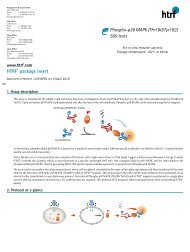

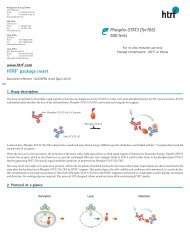
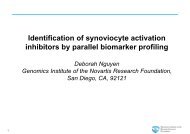
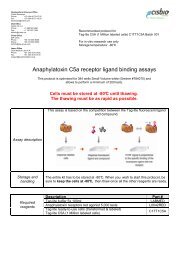
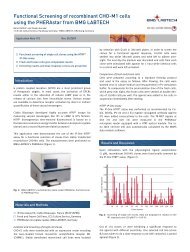
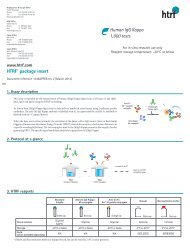
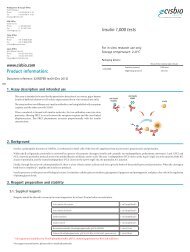
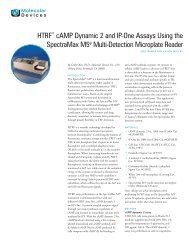

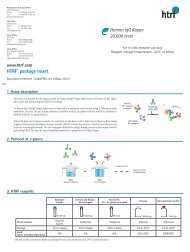
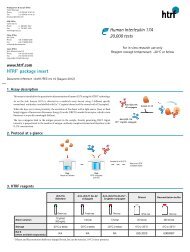

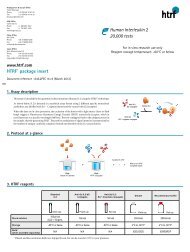
![HTRF meeting_130426_villa_pour pdf [Mode de compatibilité]](https://img.yumpu.com/22345646/1/190x135/htrf-meeting-130426-villa-pour-pdf-mode-de-compatibilitac.jpg?quality=85)